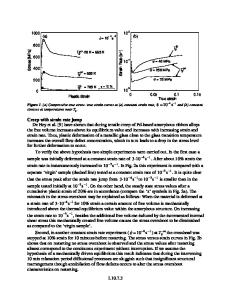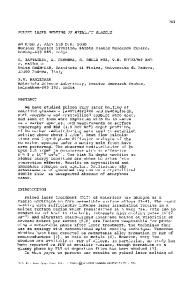Calculation of the Crystallization Behaviour of Metallic Glasses
- PDF / 155,383 Bytes
- 5 Pages / 420.48 x 639 pts Page_size
- 68 Downloads / 339 Views
225
CALCULATION OF THE CRYSTALLIZATION BEHAVIOUR OF METALLIC GLASSES H.W. BERGMANN AND H.U. FRITSCH Institut far Werkstoffkunde und Werkstofftechnik, Universitat Clausthal, West Germany ABSTRACT A method is proposed to calculate the crystallization behaviour of multicomponent metallic glasses with several phases. Various geometric shapes of precipitate can be considered. The model also takes into account changes in concentration which arise during precipitation. INTRODUCTION The crystallization behaviour of metallic glasses can be determined by calorimetry and x-ray methods only for times between a few minutes and a few hours. It is necessary to know the behaviour at very short (10 4sec) and relatively long (years) times. This requires reliable methods of extrapolation.[1] Several authors assume that crystallization can be described by an Avrami function and determine experimentally the activation energy. In the general case it must be assumed that several activation energies are necessary to descibe nucleation and growth of each phase. In the present work the crystallization behaviour is simulated by an iterative process. THEORY Crystallization can in general be described by a model which considers both nucleation and subsequent grain growth [2]. The crystallized volume Z can be expressed by Z(t) = I - exp (f
V(T)I(T) dT)
(1)
I is the frequency of nucleation, V the volume of crystallite. The volume V depends on the rate of growth u and the shape of the crystallite. V = gubtb
where b = 1,2 or 3
(2)
For spherical crystallites g = -u and b = 3. For plate like crystallites g = TED and b = 2 where D is the plate &hickness. g = F, the cross sectional area and b = 1 for needle shaped precipitates. The growth and nucleation frequency I are dependent on the instant aneous concentration so that it is reasonable to describe the change in concentration.by an iterative process, [3]. In the general case there are BR. k components, j = 1...m in the system from which stable or metastable phases P , k = 1...1 can precipitate. The initial = 1. For a given temnerature T and concentration F = k
. .
.=1_.k.
concentration Z the phases P precipitate with composition x (o)(x ..... ,x) k k m k with SE3x = 1. At a time t =n.At the volume fraction (Z ) of the phase P is n n j1 0 given by nZ(Zýk-Zki-I Zk1.= i=1I = zk n Z nEA =1
(3)
226 The total crystallization volume of all phases at the time is n kln If this calculation is carried out for several temperatures a TTC curve can be drawn. The concentration cm of the uncrystallized glass at the time t n can be caln . culated from the concentration at the time tn- and the change caused by the precipitation of the phases during At=t n-t n-i n 1 cn
kk-1
(5) nX (n-1) n If the apperance of several phases and the resultant change in concentration is taken into account in equation (1) then the total crystallizied volume is given by tn C=n-i
I1-Z k~h
Zn = Z(tn) = i-exp (_fo0nk1 Vk()Ik(r) dv) and the crystallized Zk= zk(t
(6)
volume fraction (Zn) of the phase Pk
fon Vk(s)ik(s) exp (-
Data Loading...











